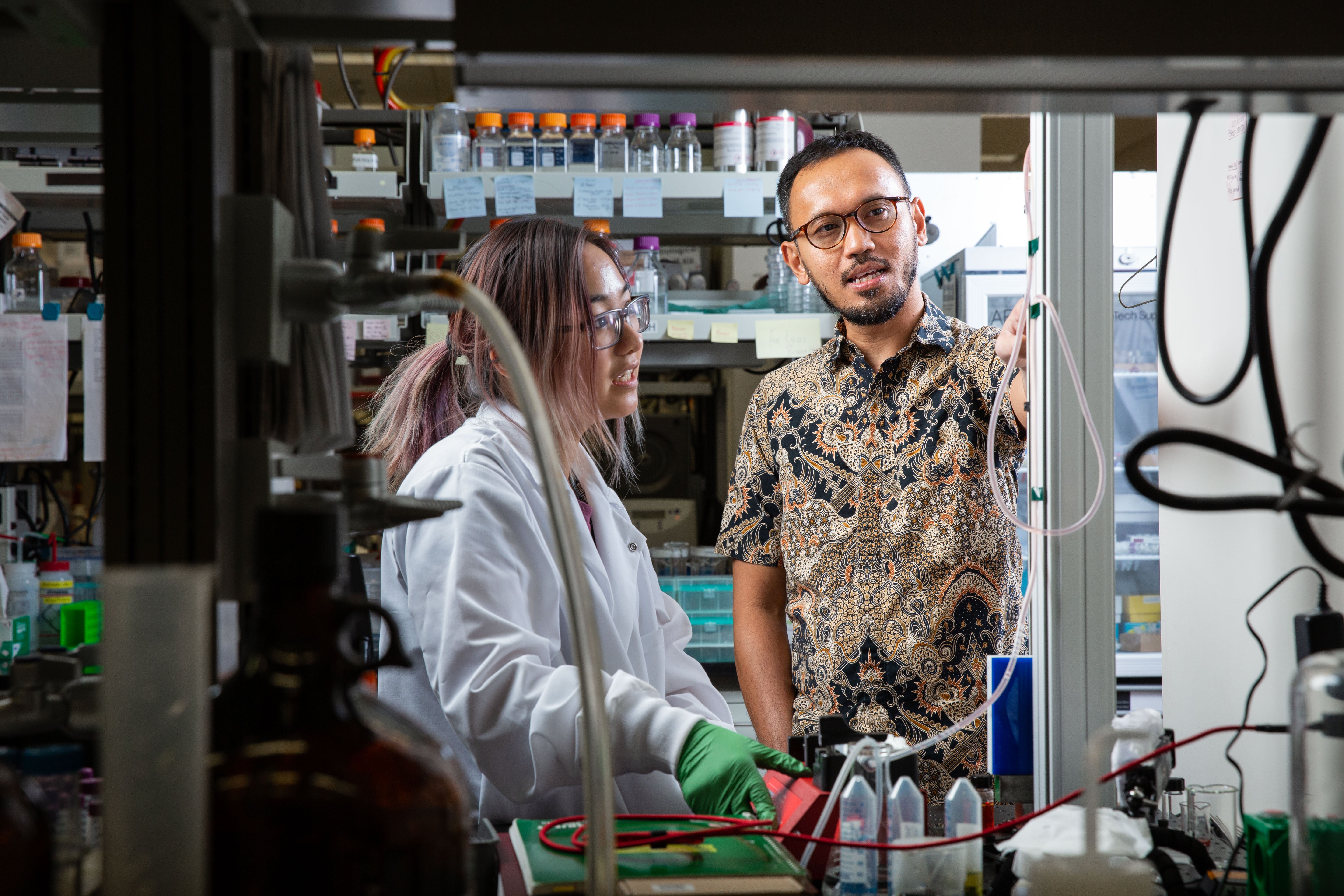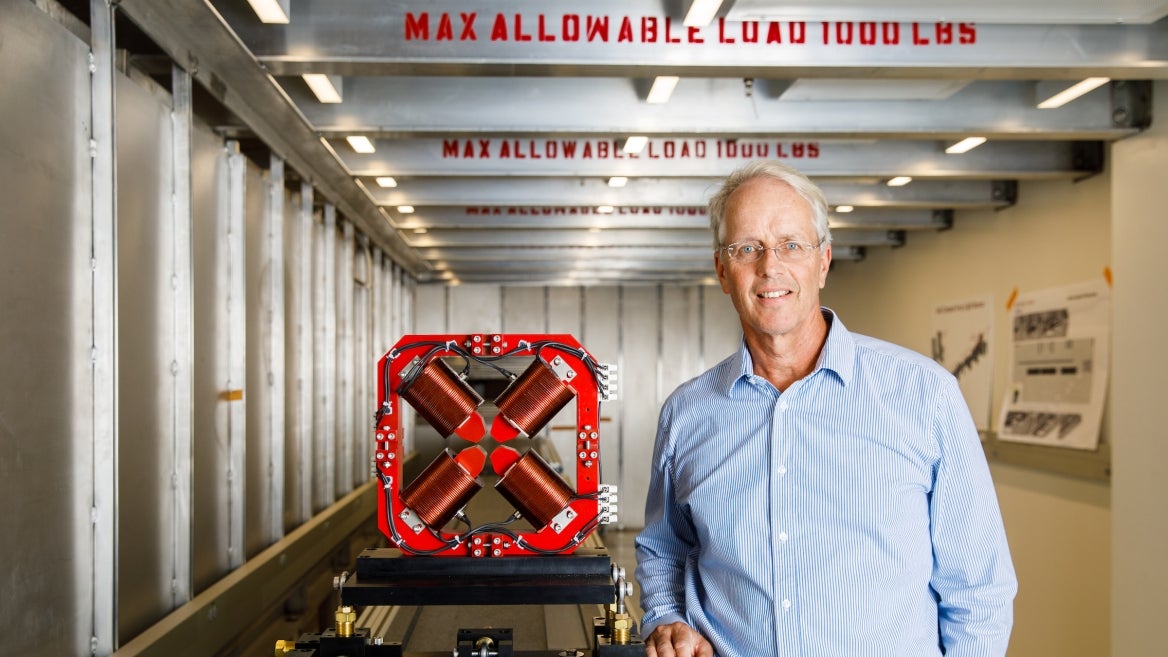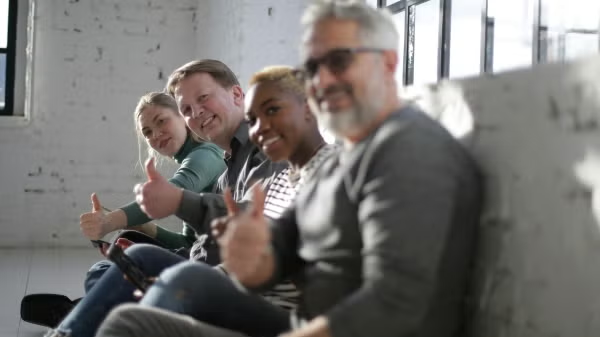More than just answers: ASU’s Department of Physics is teaming up for solutions

The Department of Physics at Arizona State University is a part of The College of Liberal Arts and Sciences and has four key research areas, with faculty and students in more than eight collaborative initiatives across disciplines and institutions.
At one time or another, we were all scientists. There is a reason a child’s first questions include: “What is it?”, “Why?” and “How?”
A physicist never loses that sense of wonder, that drive to understand something that, for now, might remain a mystery. Albert Einstein himself claimed that his real talent was not a superior intelligence, but a passionate and never-ending curiosity. The study of physics has always been about a quest for answers.
But all the answers in the world wouldn’t do any good if they aren't shared. That is why the Department of Physics at Arizona State University capitalizes on every opportunity to collaborate for greater success — to look beyond answers to solutions.
Through groundbreaking collaborations and new initiatives, the school's faculty are applying the core fundamentals of physics to challenging new problems and teaming up with researchers in other disciplines to tackle some of today’s most urgent problems, such as sustainable energy, advancing technology, global health, and the composition of the universe.
Of course, this mindset does not only apply to the faculty — after all, they are not merely researchers; they are also teachers, and their legacy is their students. They welcome passionate, curious, hard-working students of all ages and give them every tool they need to choose their path and make a difference in the world.
This is why student research — at every level — is at the heart of the department’s operating strategy.
From undergraduate students to postdoctoral scholars, Department of Physics researchers have contributed to many groundbreaking discoveries. Whether testing a process to draw energy from diamond particles using sunlight or patenting a new method of blood analysis that could lead to faster diagnosis, each facet of the Department of Physics contributes to a brighter, sustainable future.
New methods for old problems
Reaching across typical academic unit boundaries, the faculty are bringing their expertise in the principles of physics to explore old problems in a new context. The Center for Biological Physics (CBP) applies tools and methods for gathering, examining and interpreting data to better understand biological phenomena as active matter, potentially changing the way we view life and treat illness.
CBP brings together faculty from physics, chemistry and engineering to study life at different scales, not merely at the organism level — but at the molecular level. CBP Director and Professor Banu Ozkan is working to unravel the recipe of life itself by studying the way proteins are able to form into complex and functional systems based purely on the signals inherent in their DNA. Understanding how these genetic sequences combine to direct life could be the first step toward exerting any control over the process — which would allow us to get ahead of antibiotic-resistant bacteria and develop drugs to target disease with pinpoint accuracy.
An associate professor at ASU, Banu Ozkan and two of her grad students, Paul Campitelli and Tushar Modi, explore correlations between principles of physics and biological systems and look for applications for a better understanding of proteins and evolution.
Steve Pressé, an associate professor in both the Department of Physics and the School of Molecular Sciences, is developing new strategies to extract information on processes occurring deep within living cells. Working within CBP, Pressé recently received two single-PI R01 grants from the National Institutes of Health to develop methods to track individual molecules as well as monitor their chemical changes from imaging data.
"We all know about tracking missiles, but tracking missiles is easy compared to tracking individual molecules inside cells," he said. "Molecules cannot be directly imaged. Rather, we use a smattering of photons collected over a region about a hundred times the size of a single molecule to pinpoint its location. Intersecting molecular paths then cause challenges completely foreign to tracking large objects like missiles."
The ability to track the movement of molecules, their assembly into larger clusters as well as their disassembly within cells, could shed immediate insight into the rules of life.
“What is different today, as compared to even just a few years ago, is our ability to exploit new tools of mathematics and data science to literally exploit individual photons, light particles, emitted by molecules we care about to extract information on molecules at rapid time scales, previously unachievable, at which important biological events occur," said Pressé.
“Because these things we are studying are so incredibly tiny, we are talking about a lot of data, a lot of signals,” he said. “And because of the computers we currently have access to, we have the ability to process so much more information — which allows us to not only be descriptive, but quantitative.”
A coordinated attack on global challenges
Another ASU initiative employing physics principles to tackle biological questions and topics is the Biodesign Institute. Occupying over 550,000 square feet, the Biodesign Institute represents Arizona’s single largest research infrastructure in the biosciences. Faculty, students and researchers are bringing their vast experience and perspective to reimagine the “design rules” found in nature and searching for patterns and clues to tackle current global health challenges in health care, sustainability and security.

In 2018, physics Professor Rizal Hariadi received the NIH New Innovator Award for his proposal focusing on the functionality of a biomolecular system when force is applied, specifically in the context of malaria parasite invasion. Photo by Deanna Dent/ASU Now
For Rizal Hariadi, assistant professor in the Department of Physics and an investigator for the Biodesign Center for Molecular Design and Biomimetics, an intensive interdisciplinary environment was the perfect fit.
Already heavily involved in research combining physics, biology, chemistry and mechanical engineering, Hariadi often evoked the question, "Why are you here?" when applying to departments at other institutions. ASU's Biodesign Institute, one of only a few collaborations of its kind, was a welcome harbor.
Hariadi established the Biomolecular Mechanics and Nanotechnology Laboratory (BIOMAN LAB), a highly inclusive research group looking to gain a greater understanding of the origin of life by exposing the fundamental physical forces that determine how cells respond to mechanical forces.
This ambitious group includes a diverse set of researchers, ranging from high school to postdoctoral scholars. He also employs a far less common addition: comic illustrators.
He encourages students to use their time to get involved and to do everything they can to find the answers to the questions they are most passionate about. Including undergraduates gives them the chance to be a part of something bigger than themselves, and to explore and develop their interests and creativity.
“Life is short,” he said. “I’m not going to send students to do something that I find less impactful, or not interesting. I want it to be interesting and important.”
And Hariadi is not the only one who feels that way. The Biodesign Institute brings together 132 tenured research faculty with over 200 active research projects, and it has established more than a dozen different research centers and labs.
The only tools for the job
Award-winning facilities and advanced research technology play a significant role in ASU’s research atmosphere and culture. Many of the experimental projects pursued by faculty and students would not be possible anywhere else.
In addition to the use of advanced computational methods and technology, ASU is home to the Eyring Materials Center, three facilities that provide incredible equipment of materials research and the solid-state sciences. Foremost among these is the world-renowned John M. Cowley Center for High-Resolution Electron Microscopy, with its unique collection of advanced electron microscopes used for exploring the atomic structure of many types of emerging materials.
Through the incredible work conducted today and the phenomenal facilities underway, the Department of Physics is crafting a program that will carry forward and establish a legacy for all its future students and researchers.

Technology of this magnitude has never been built to this scale. The Compact X-ray Free Electron Laser will be the only one of its kind, bringing the power of a national lab to Biodesign's Building C.
Construction is ongoing for a one-of-a-kind Compact X-ray Free Electron Laser (CXFEL). Uniquely small and uniquely powerful, the device is the creation of Associate Professor William Graves and will open the door to countless potential breakthroughs in capturing and imaging chemical reactions and material changes in motion. The monumental project, which just received a tremendous boost of $4.7 million from the National Science Foundation, is the result of decades of work from researchers across the globe.
ASU Regents Professors John Spence, the Richard Snell Professor of Physics, and Petra Fromme, the Paul V. Galvin Professor of Molecular Sciences, were part of a worldwide team to develop the first theory and methodology to peer ever deeper into the biological world using XFELs in 2010.
Spence is a crucial member of the Biodesign Center for Applied Structural Discovery (BioXFEL), a consortium dedicated to advancing science, medicine, and health with the help of new technology — such as the new CXFEL — that allows scientists to capture biological molecules in atomic detail. Resources like this will lead to momentous discoveries and fuel new collaborations and innovations in the years to come.
Establishing a legacy
Biology is not the only area where physics reaches across boundaries to answer formidable questions. From the microscopic to the astronomical, the Cosmology Initiative bridges the School of Earth and Space Exploration and the Department of Physics to explore the answers of the universe and particle physics.
Physics Professor and Undergraduate Program Director Richard Lebed hopes the next generation of theoretical physicists can build on current research to push even further into the ever-more peculiar subatomic particles that compose our universe.
Lebed is studying the nature of exotic hadrons: particles made up of four or more quarks. Typical hadrons, such as protons and neutrons, are made of two or three quarks. Exotic hadrons were entirely unknown until very recently. And despite being sure of their existence — and their many varieties — science does not currently have a model that accurately describes their properties and structure — something Lebed and his team of students are aiming to fix.
ASU physics Professor Richard Lebed and two of his students, Curtis Peterson and Jesse Giron, explore the theories and properties of subatomic particles.
Perhaps the most mysterious substance at the moment is dark matter. Thought to be approximately 27% of the universe, we currently have a far better idea of what dark matter isn’t than what it is. Professor Frank Wilczek is eager to change that.
Wilczek, who won the 2004 Nobel Prize in physics, is looking forward to working on several new projects to explore theoretical materials like anyons, quantum particles that exist in two-dimensional spaces, and axions, hypothetical elementary particles that could even be the dark matter science has been looking for.
Shaping the layers of future technology
Seeking to close the gap between theory and practice, The Science Hub is a new ASU initiative that combines interdisciplinary research, teaching and product development.
The Science Hub, or “SciHub,” is the work of both Wilzcek and Nathan Newman, Lamonte H. Lawrence Professor in Solid State Science in ASU’s Ira A. Fulton Schools of Engineering. This unique collaboration across colleges and disciplines aims to show the process of taking a theoretical idea clear through to the creation of an application in the form of technology or software.
“ASU has created an entrepreneurship atmosphere where this kind of adventure is encouraged, and it is very attractive to me,” Wilczek said.
The Nanoscience and Materials Physics Program is another research area within the Department of Physics with an eye toward possible commercial applications. Faculty, researchers and students are creating and studying new materials at the forefront of the future’s technological breakthroughs.
Multiple faculty collaborators are conducting remarkable work with an equally remarkable material: diamond.
In his lab, ASU physics Professor Robert Nemanich and his research group, including Graduate Research Assistant Yu Yang, have shown that we can make electronic technology using diamond.
Diamond’s uniquely stable molecular structure, as well as its durability under incredible heat and pressure, makes it ideal for countless potential applications. Many of the diamonds used in current experiments are “doped diamonds,” with layers grown and prepared right here on ASU’s campus.
“Everyone looks at it, and they see a beautiful, sparkling gemstone, and the properties we are interested are not that,” said Robert Nemanich, Regents Professor and trailblazer of the research area. “We’re more interested in getting a current to run through a diamond.”
The study of the electrical properties of diamonds has fascinating implications in the fields of electronic technologies and sustainable energy. And the research is well beyond theoretical at this point.
Advent Diamond Inc. is a startup company led by ASU alumna Manupeet Benipal, who serves as CEO. Nemanich and Anna Zaniewski, instructional professional for the Department of Physics, are also a part of the team, taking ideas and materials developed in the laboratory and exploring their commercial applications.
One ongoing project, funded through NASA, involves the design and use of diamond electronics able to function at temperatures of 500 degrees Celsius, potentially enabling a mission to Venus utilizing diamond electronic technology.
A lifelong curiosity
At the end of the day, a physicist is more than papers published and prizes won. It is someone who has developed a mindset of solving problems that will shape the rest of his or her life.
A physicist is never bored — because they see amazing things happening in the world around them and continue to develop new interests and explore novel curiosities.
A physicist recognizes that much of life is a series of experiments. We try, we fail, we make changes and try again, and again, until we finally succeed.
And a physicist knows that there is so much we can learn from each other. Collaboration is often the element that turns answers into long-term solutions.
More Science and technology
Statewide initiative to speed transfer of ASU lab research to marketplace
A new initiative will help speed the time it takes for groundbreaking biomedical research at Arizona’s three public universities…

ASU research seeks solutions to challenges faced by middle-aged adults
Adults in midlife comprise a large percentage of the country’s population — 24 percent of Arizonans are between 45 and 65 years…

ASU research helps prevent substance abuse, mental health problems and more
Smoking rates among teenagers today are much lower than they were a generation ago, decreasing from 36% in the late 1990s to…